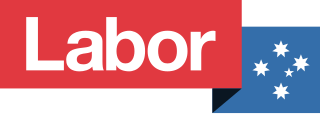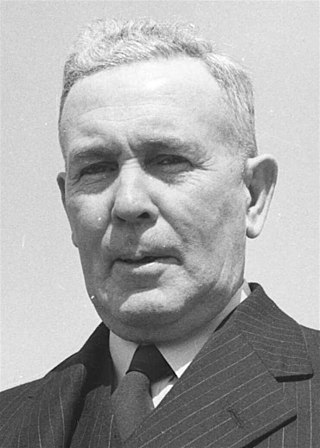
The Australian Labor Party (ALP), also simply known as Labor, is the major centre-left political party in Australia, one of two major parties in Australian politics, along with the centre-right Liberal Party of Australia. The party forms the federal government since being elected in the 2022 election. The ALP is a federal party, with political branches in each state and territory. They are currently in government in Victoria, Queensland, Western Australia, South Australia, the Australian Capital Territory, and the Northern Territory. They are currently in opposition in New South Wales and Tasmania. It is the oldest political party in Australia, being established on 8 May 1901 at Parliament House, Melbourne, the meeting place of the first federal Parliament.

Joseph Benedict Chifley was an Australian politician who was the 16th prime minister of Australia from 1945 to 1949. He held office as the leader of the Australian Labor Party (ALP) from 1945, following the death of John Curtin on 5 July, until his own death in 1951.

Arthur Augustus Calwell was an Australian politician who served as the leader of the Labor Party from 1960 to 1967. He led the party to three federal elections.

The Communist Party of Australia (CPA), known as the Australian Communist Party (ACP) from 1944 to 1951, was an Australian political party founded in 1920. The party existed until roughly 1991, with its membership and influence having been in a steady decline since its peak in 1945. Like most communist parties in the west, the party was heavily involved in the labour movement and the trade unions. Its membership, popularity and influence grew significantly during most of the interwar period before reaching its climax in 1945, where the party achieved a membership of slightly above 22,000 members. Although the party did not achieve a federal MP, Fred Paterson was elected to the Parliament of Queensland at the 1944 state election. He won re-election in 1947 before the seat was abolished. The party also held office in over a dozen local government areas across New South Wales and Queensland.
The Australian labour movement began in the early 19th century and since the late 19th century has included industrial and political wings. Trade unions in Australia may be organised on the basis of craft unionism, general unionism, or industrial unionism. Almost all unions in Australia are affiliated with the Australian Council of Trade Unions (ACTU), many of which have undergone a significant process of amalgamations, especially in the late 1980s and early 1990s. The leadership and membership of unions hold and have at other times held a wide range of political views, including communist, socialist and right-wing views.

On 22 September 1951, a referendum was held in Australia which sought approval to alter the Australian Constitution to give Parliament the power to make laws regarding communism and communists, so that the Parliament would be empowered to instate a law similar to the Communist Party Dissolution Act of 1950. It was not carried.

Donald MacLennan Grant was a leader of the Industrial Workers of the World in Sydney, a member of the Sydney Twelve charged with conspiracy in 1916, and later a member of the Australian Labor Party who was elected to Sydney City Council, appointed to the New South Wales Legislative Council, and elected to the Australian Senate in 1943 where he served for sixteen years.
Black Friday, in British labour history, refers to 15 April 1921, when the leaders of transport and rail unions announced a decision not to call for strike action in support of the miners. The epithet 'black' derives from a widespread feeling amongst labour radicals that the decision amounted to a breach of solidarity and a betrayal of the miners.
Timeline of trade union history
Usually referred to as the "New South Wales General Strike", but referred to by contemporaries as "the Great Strike", it was in fact neither general nor confined to NSW. The strike was however a mass strike, involving around 100,000 workers, mostly in NSW and Victoria. It began in the Australian state of New South Wales and spread to other states over six weeks from 2 August to 8 September 1917 when the official leadership declared the strike over. It took two weeks for all the railway strikers to return, however, as rank and file meetings initially rejected the official capitulation. Outside the railways, significant groups such as the waterside workers in Sydney and Melbourne, and the Hunter Valley coal mines remained out until November as in their case the use of strikebreakers had turned the strike into a lockout.

Frederick Carl Katz was an Australian trade unionist and politician. He had a long association with the Australian labour movement, holding senior leadership positions with the Federated Clerks' Union, Federal Miscellaneous Workers' Union, and the Melbourne Trades Hall. He served as a Senator for Victoria from 1947 to 1951, representing the Australian Labor Party (ALP).

The Chifley government was the federal executive government of Australia led by Prime Minister Ben Chifley. It was made up of members of the Australian Labor Party in the Australian Parliament from 1945 to 1949.
The history of the Australian Labor Party has its origins in the Labour parties founded in the 1890s in the Australian colonies prior to federation. Labor tradition ascribes the founding of Queensland Labour to a meeting of striking pastoral workers under a ghost gum tree in Barcaldine, Queensland in 1891. The Balmain, New South Wales branch of the party claims to be the oldest in Australia. Labour as a parliamentary party dates from 1891 in New South Wales and South Australia, 1893 in Queensland, and later in the other colonies.

The Waterside Workers' Federation of Australia (WWF) was an Australian trade union that existed from 1902 to 1993. After a period of negotiations between other Australian maritime unions, it was federated in 1902 and first federally registered in 1907; its first general president was Billy Hughes.

The Black Armada was a name applied to Dutch merchant and military vessels which were prevented from sailing to the newly proclaimed independent Indonesia from Australian ports due to waterfront strikes or 'black bans' by maritime trade unions from 1945 to 1949.
The history of trade unions in the United Kingdom covers British trade union organisation, activity, ideas, politics, and impact, from the early 19th century to the present.
Rupert Ernest Lockwood was an Australian journalist and communist activist.
The Dalfram dispute of 1938 was a political industrial dispute at Port Kembla, New South Wales, protesting the export of pig iron from Australia to Japan during the Second Sino-Japanese War. It became famous for providing the nickname of Pig Iron Bob to Attorney General Robert Menzies, later to serve as Prime Minister.
The Australian Coal and Shale Employees' Federation was an Australian trade union representing workers in the coal mining industry from 1913 to 1990.

Edward Charles Roach (1909–1997), was an Australian trade unionist, long-time leader of the Waterside Workers' Federation (WWF) and prominent member of the Communist Party of Australia. He was a key organiser of the 1938 Dalfram dispute, when dock workers, concerned with the occupation of China, refused to load ships destined for Japan with Australian pig-iron, a raw material for munitions. He was twice imprisoned for his industrial activity. As a leader in the WWF during the introduction of containerisation, he was responsible for winning significant improvements in working conditions for those in the Australian stevedoring industry.











